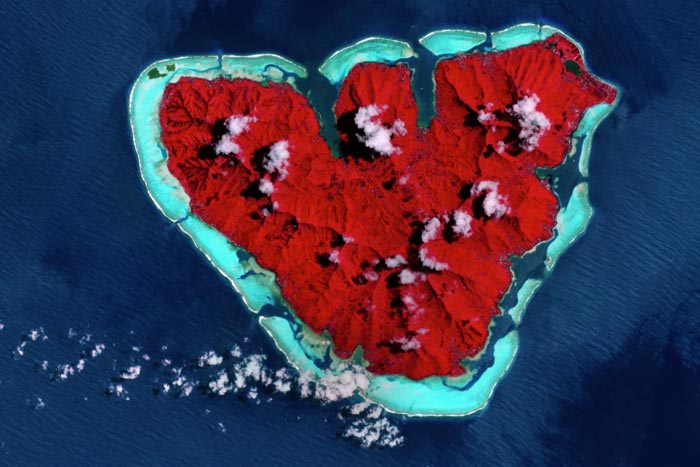The Heart Of Climate Change: New ESA Image Shows 'Island Love' Under Threat
Consider this picture a love letter — from Planet Earth. Just in time for Valentine's Day, this cute new "island love" space image shows the heart-shaped island of Moorea in French Polynesia. But the picture also stands as a stark symbol of climate change, the European Space Agency says.
"Moorea is part of a chain of islands formed by hot-spot volcanism. This means that volcanoes are created by 'fixed' hot areas in Earth's mantle," ESA officials said in a statement accompanying the image, which was taken by the satellite Copernicus Sentinel-2. ESA further explained that plate tectonics — the movement of the Earth's surface over time — forces the plate away from the hotspot. This process gradually carries hotspot volcanoes to a new location while, at the hotspot, new volcanoes form.
"These kinds of islands are constantly changing, eroding and sinking back into the ocean over millions of years," ESA added. "However, changes are taking place at a much faster rate because of the marks human activity leaves on the natural landscape and because of climate change."

While you may think the image was dyed red just for Valentine's Day, ESA explained that the image processing turns vegetation red — revealing that Moorea is home to a lush ecosystem. Humans have inhabited this island for 1,200 years and continue to alter its vegetation.
Another delicate part of Moorea lies just around the island. The coral reef in that area appears pristine for now, ESA said, but like all coral reefs it faces dangers from ocean plastics, fishing and pesticide runoff from agriculture. In general, coral reefs around the world are dying in large part due to rising temperatures, which are linked with ocean acidification and hurt or kill corals themselves.
ESA officials said that through images like these, satellites like Sentinel-2 remind scientists and the public how fragile Earth is. The satellite is also part of a network of sentinels that send information back to Earth about climate change and how local ecosystems are responding to that change — helping us learn how to better love the Earth.
Follow us on Twitter @Spacedotcom and on Facebook.
Get the Space.com Newsletter
Breaking space news, the latest updates on rocket launches, skywatching events and more!
Join our Space Forums to keep talking space on the latest missions, night sky and more! And if you have a news tip, correction or comment, let us know at: community@space.com.

Elizabeth Howell (she/her), Ph.D., was a staff writer in the spaceflight channel between 2022 and 2024 specializing in Canadian space news. She was contributing writer for Space.com for 10 years from 2012 to 2024. Elizabeth's reporting includes multiple exclusives with the White House, leading world coverage about a lost-and-found space tomato on the International Space Station, witnessing five human spaceflight launches on two continents, flying parabolic, working inside a spacesuit, and participating in a simulated Mars mission. Her latest book, "Why Am I Taller?" (ECW Press, 2022) is co-written with astronaut Dave Williams.









